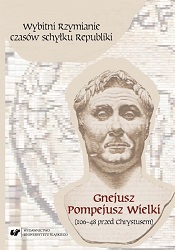Nemezis z grobowca Pompeiusa
Nemesis and the grave of Pompey
Author(s): Paweł Madejski
Subject(s): History
Published by: Wydawnictwo Uniwersytetu Śląskiego
Summary/Abstract: In 41 AD Claudius started to produce a brand new series of coins with an unprecedented iconography: Nemesis with a legend PACI AVGVSTAE. The coins were minted until 52 AD. Modern historians offer a very sophisticated explanation of the Claudius’ reasons to exploit this iconography. First, it was supposed to be base on the Roman understanding of pax: war was an instrument of punishing the superbi, so pax as a result of it could be linked to Nemesis. It is trueNemesis and Pax were juxtaposed and connected. Second part of the explanation presupposes that Claudius used the figure of Nemesis from the Pompey’s tomb as a model. This Nemesis commemorated the punished ὕβρις of Pompey. The outlined explanation was elaborated by Michail Rostovtzeff (who based his interpretation on the earlier comments by Joseph Eckhel).Eckhel-Rostovtzeff hypothesis is, however, based on very weak foundations. Claudius usedNemesis to express the meaning of the Roman concept of pax. The reason for this was quite simple: he came to power after the assassination of Caligula, in the time when the Romans observed a feast of Pax. Moreover, there are no suggestions in the preserved testimonies that Caesar wanted to denigrate the memory of his main opponent. Caesar ordered to bury the remains of Pompey and dedicated to Nemesis the plot of landfor this purpose. He did so because he aspired to be seen as a decent Roman who punished the death of his fellow citizen (and a friend, colleague, son-in-law). Probably Caesar also allowed Cornelia to transfer the ashes from the Alexandrian Nemeseion to Alba, but besides Plutarch no other source confirms that such an act in fact ever took place.
Book: Wybitni Rzymianie czasów schyłku Republiki. Gnejusz Pompejusz Wielki (106–48 przed Chrystusem)
- Page Range: 191-203
- Page Count: 13
- Publication Year: 2018
- Language: Polish
- Content File-PDF

